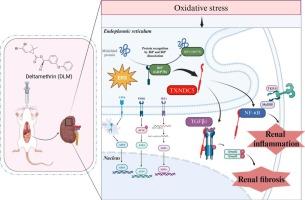Deltamethrin exposure caused renal inflammation and renal fibrosis via upregulating endoplasmic reticulum stress-mediated TXNDC5 level in mice
IF 4.2
1区 农林科学
Q2 BIOCHEMISTRY & MOLECULAR BIOLOGY
引用次数: 0
Abstract
Deltamethrin (DLM) is a type II pyrethroid insecticide that is extensively applied to agriculture, veterinary medicine and livestock pest control. Excessive accumulation of DLM in the body can lead to nephrotoxicity, but the precise toxic mechanism remains obscure. Therefore, we established in vivo models of DLM-exposed mice for 30 days and in vitro models of DLM-exposed renal tubular epithelial cells of mice. The results revealed adverse effects on renal function in mice exposed to excessive DLM, manifested as endoplasmic reticulum (ER) swelling, local inflammatory infiltration in renal tissue and increased collagen fibers, suggesting renal inflammation and fibrosis, etc. Subsequently, in vivo experiments, we found that DLM exposure increased expression levels of endoplasmic reticulum stress (ERS)-related factors, significantly upregulated the expression of TXNDC5, and enhanced the colocalization of GRP78 with TXNDC5. Notably, DLM exposure also strengthened the co-localization of TXNDC5 with NF-κB p65 and TGF-β1, upregulated the expression levels of TLR4/MYD88/NF-κB and TGF-β/SMAD2/3 pathways, alongside inflammation and fibrosis-related factors, these changes exhibited a dose-dependent effect. Meanwhile, in vitro experiments, the results of ERS, inflammation, and fibrosis-related factor expression levels were consistent with those observed in vivo. In conclusion, our results demonstrated that TXNDC5 might played a certain role in DLM-induced nephrotoxicity. Specifically, DLM exposure could trigger ERS, increase TXNDC5 expression, and promote TLR4/MYD88/NF-κB and TGF-β/Smad2/3 pathways, leading to renal inflammation and fibrosis in mice. These discoveries not only deepen our understanding of DLM toxicity but also provide valuable avenues for exploring mitigation strategies and therapeutic interventions.

接触溴氰菊酯可通过上调内质网应激介导的 TXNDC5 水平引起小鼠肾脏炎症和肾脏纤维化
溴氰菊酯(DLM)是一种 II 型拟除虫菊酯杀虫剂,被广泛应用于农业、兽医和牲畜害虫控制领域。DLM在体内的过度积累会导致肾毒性,但其确切的毒性机制仍不清楚。因此,我们建立了暴露于 DLM 30 天的小鼠体内模型和暴露于 DLM 的小鼠肾小管上皮细胞体外模型。结果显示,暴露于过量 DLM 的小鼠肾功能受到不良影响,表现为内质网(ER)肿胀、肾组织局部炎症浸润和胶原纤维增加,提示肾脏炎症和纤维化等。随后,我们在体内实验中发现,DLM 暴露增加了内质网应激(ERS)相关因子的表达水平,显著上调了 TXNDC5 的表达,并增强了 GRP78 与 TXNDC5 的共定位。值得注意的是,暴露于DLM还加强了TXNDC5与NF-κB p65和TGF-β1的共定位,上调了TLR4/MYD88/NF-κB和TGF-β/SMAD2/3通路以及炎症和纤维化相关因子的表达水平,这些变化表现出剂量依赖性效应。同时,在体外实验中,ERS、炎症和纤维化相关因子表达水平的结果与在体内观察到的结果一致。总之,我们的研究结果表明,TXNDC5可能在DLM诱导的肾毒性中发挥了一定的作用。具体而言,DLM暴露可引发ERS,增加TXNDC5的表达,促进TLR4/MYD88/NF-κB和TGF-β/Smad2/3通路,从而导致小鼠肾脏炎症和纤维化。这些发现不仅加深了我们对 DLM 毒性的了解,还为探索缓解策略和治疗干预措施提供了宝贵的途径。
本文章由计算机程序翻译,如有差异,请以英文原文为准。
求助全文
约1分钟内获得全文
求助全文
来源期刊
CiteScore
7.00
自引率
8.50%
发文量
238
审稿时长
4.2 months
期刊介绍:
Pesticide Biochemistry and Physiology publishes original scientific articles pertaining to the mode of action of plant protection agents such as insecticides, fungicides, herbicides, and similar compounds, including nonlethal pest control agents, biosynthesis of pheromones, hormones, and plant resistance agents. Manuscripts may include a biochemical, physiological, or molecular study for an understanding of comparative toxicology or selective toxicity of both target and nontarget organisms. Particular interest will be given to studies on the molecular biology of pest control, toxicology, and pesticide resistance.
Research Areas Emphasized Include the Biochemistry and Physiology of:
• Comparative toxicity
• Mode of action
• Pathophysiology
• Plant growth regulators
• Resistance
• Other effects of pesticides on both parasites and hosts.

 求助内容:
求助内容: 应助结果提醒方式:
应助结果提醒方式:


